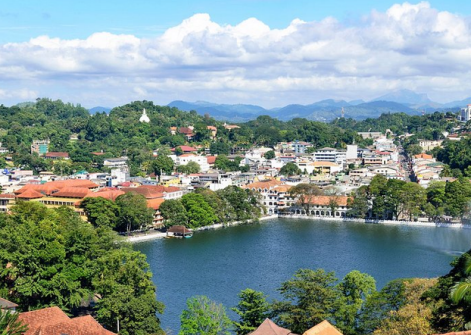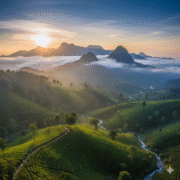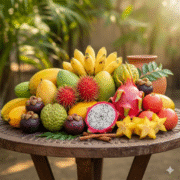
Kandy: An Expert-Curated Guide by Eunoia Lanka Tours
- September 3, 2025
- eunoialankatours
- 5:37 pm
We at Eunoia Lanka Tours think that having accurate information and knowledge of the area are essential for a successful trip. Our travel experts live in Sri Lanka’s hill region and go back to the holy city of Kandy often to make sure that our advice is correct and up to date. This article is based on reliable sources including UNESCO records, official publications, and peer-reviewed research. It is also better since our guides have been there and done that. Here is a complete list of Kandy’s best features to help you explore this UNESCO World Heritage city with confidence and respect.
A sacred city with royal roots
The city of Kandy is in a basin surrounded by hills. It grew up around an artificial lake that was made in 1807. The Temple of the Sacred Tooth Relic is part of its historic centre, which is a UNESCO World Heritage site. Sri Lankan Buddhists believe that the tooth of the Buddha is the most sacred relic on the island. The temple, which is part of the royal palace complex, holds this relic.
According to records, Princess Hemamali and Prince Dantha brought the relic from the Indian kingdom of Kalinga in the 4th century. Hemamali hid it in her hair so no one would see it. The king was given the relic in Anuradhapura, and keeping it safe became a symbol of the right to rule Sri Lanka. Because of this, the temple is still a spiritual hub and a strong cultural emblem.
The temple is a World Heritage site because of its great cultural value. UNESCO says that the complex’s architecture, sculptures, and decorative art are the best examples of Sinhalese craftsmanship, and that its connection to the tooth relic has shaped Sri Lanka’s political history. Monks from the Malwathu and Asgiri chapters do daily rites, and every Wednesday, they symbolically bathe the relic. Visitors are welcome to watch these rituals as long as they dress modestly and act properly.
Esala Perahera – a living tradition
The most dramatic expression of Kandy’s devotion occurs during Esala Perahera, a ten-day festival held each July or August. The temple’s custodians parade a replica casket of the tooth relic on the back of a caparisoned tusker through streets lined with lanterns and devotees. Teams of drummers, whip-crackers and masked dancers perform age-old routines, while four processions representing deities Natha, Vishnu, Kataragama and Pattini join the parade.
The festival culminates with a water-cutting ceremony on the Mahaweli River at dawn. Our guides recommend arriving early to secure a viewing spot and bring a sarong or shawl for temple entry.
Colonial echoes: cemeteries and churches
Kandy’s royal capital fell to the British in 1815 and remnants of the colonial period survive. Behind the temple lies the British Garrison Cemetery, a small walled graveyard established in 1817 and closed in 1873 after a ban on burials within the city. The cemetery contains 195 graves; most occupants succumbed to tropical diseases such as malaria and cholera.
After decades of neglect, the Commonwealth War Graves Commission financed a restoration and today “The Friends of the British Garrison Cemetery” maintain the site. A short distance away is the St Paul’s Church, built in 1843 for British officials. Its Gothic interior and stained glass offer a contrast to the nearby Buddhist shrines.
The Commonwealth War Cemetery is another must-go place. It is where soldiers from World War II who fought for the allies are buried. The Commonwealth War Graves Commission takes care of the magnificent gardens. There is generally a caretaker on hand to tell the story behind the headstones.
Nature and gardens – breathing life into the city
Udawattakele Forest Reserve
On a ridge north of the lake lies Udawattakele Forest Reserve, once the private royal pleasure garden. This sanctuary covers around 104 hectares (257 acres). During the Kandyan kingdom it was known as “Uda Wasala Watta”, meaning “the garden above the royal palace”; today it is managed by the Department of Wildlife Conservation. The reserve harbours a rich understorey of lianas, shrubs and small trees, and is famous for its birdlife. Several meditation hermitages and historic caves can be reached via marked trails.
Royal Botanic Gardens at Peradeniya
To the west of town, the Royal Botanic Gardens at Peradeniya provide a different experience. Established formally in 1843, the gardens occupy 147 acres and are home to over 4,000 plant species, including orchids, spices, medicinal plants and towering avenues of palms.
In 2016 the garden welcomed approximately 1.2 million local visitors and 400,000 foreign visitors. The gardens sit on a bend of the Mahaweli River and are managed by the Department of National Botanic Gardens. A visit can easily be combined with a stroll through the adjacent University of Peradeniya; founded in 1952 and spread over 700 hectares, the campus features striking architecture, shady lanes and views of the Hanthana range.
Tea heritage – from plantation to museum
Sri Lanka’s tea story begins in the Kandy district. The Loolecondera Estate near Deltota became the island’s first tea plantation in 1867 when Scotsman James Taylor cleared 7.7 hectares (19 acres) and planted Assam hybrid seeds. Taylor established a factory on the estate in 1872 and developed techniques for rolling and firing leaves.
Loolecondera still preserves his bungalow and a small memorial; some of his equipment is displayed at the Ceylon Tea Museum in Hantane. The Ceylon Tea Museum, housed in the former Hantane tea factory about 5 km from Kandy, is managed by the Sri Lanka Tea Board.
According to the board’s description, the factory was built in 1925 and its ground floor still exhibits vintage machinery. Upper floors host interpretive displays, a library and a café; visitors can learn how tea replaced coffee in the highlands and enjoy panoramic views from the rooftop. Our guides can arrange combined tours of the museum and nearby tea estates.
Mountains and vistas
Hiking enthusiasts will appreciate the Hanthana Mountain Range, south of Kandy. Academic studies cite the area’s mean annual temperature as about 26 °C and mean annual rainfall around 1,840 mm. The range comprises an upper section with peaks like Katusu Konda (1,322 m) and a lower section around 1,140 m. Trails wind through pine plantations, tea bushes and patches of remnant forest.
Early mornings offer clear views over Kandy, while midday mists create an eerie atmosphere. Further afield, the Knuckles Conservation Range beckons adventurous hikers. A short path from the conservation centre at Deanston leads to Mini World’s End, a cliff-edge lookout offering dramatic panoramas.
Nearby villages such as Meemure provide homestays for those wanting to experience rural life. For panoramic views closer to Kandy, the viewpoint at Bahirawakanda (also known as the Bahirawakanda Vihara) rewards travellers with sweeping cityscapes and a close-up of the 26.83 m Buddha statue.
Temples and craftsmanship beyond the city
Within the Kandy district, two 14th-century temples exemplify the fusion of Sinhalese and South Indian styles. Lankatilaka Viharaya, perched on a rock near Hiyarapitiya, was commissioned in 1344 AD during the reign of King Buvanekabahu IV.
Nearby Gadaladeniya Viharaya is built entirely from granite and houses both Buddhist and Hindu sanctuaries. Closer to Pilimathalawa, another temple dating from the mid-14th century is dedicated to the god Kataragama. Its three halls – the sanctum, the dancing hall and the drummers’ hall – are celebrated for exquisite wooden pillars carved with mythical creatures and geometric motifs.
Workshops in the nearby village still produce drums and brassware using traditional techniques; visiting these artisans supports their livelihoods and offers an insight into Kandyan craftsmanship.
Practical tips and responsible travel
- Dress respectfully when entering temples. Shoulders and knees should be covered, and footwear must be removed before entering the Temple of the Tooth. Carry socks to avoid hot paving stones.
- Plan ahead for festivals. Esala Perahera draws large crowds; secure accommodation early and be prepared for road closures and security checks. Our guides can arrange reserved seating for the procession.
- Hire licensed guides. Many sites, including Udawattakele and the Ceylon Tea Museum, have official guides or interpretation panels. Eunoia Lanka Tours works with accredited guides to ensure accurate information.
- Support local communities. When buying crafts in Pilimathalawa or visiting villages like Meemure, pay fair prices and respect local customs. Photography is generally welcomed but always ask permission.
Why trust Eunoia Lanka Tours?
This guide reflects experience and expertise. Our team has lived and worked in the Kandy region for years; we have walked the forest trails, participated in religious ceremonies and interviewed museum curators. We cross-checked facts with reliable references such as UNESCO listings, government publications and scholarly articles, and we cite them here so you can verify the information yourself.
By combining these sources with our personal insights, we strive to deliver trustworthy, practical advice. If you plan to explore the sacred city and its surroundings, Eunoia Lanka Tours will craft an itinerary tailored to your interests while honouring the cultural and natural heritage of this remarkable region.


